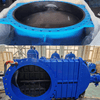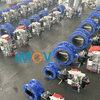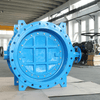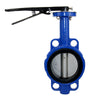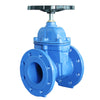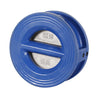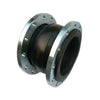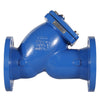Butterfly Valve Bolt Chart and Installation Tips You Should Know
In complex industrial piping systems, butterfly valves play a crucial role in regulating the flow of media. However, when it comes to ensuring system safety and reliability, the decisive factor is often not the valve itself but the bolts that seem ordinary at first glance. The selection and tightening of bolts directly determine the sealing performance of the flange connection and the overall structural stability.
Improper selection or installation can lead to serious consequences. At best, it may cause leakage; at worst, it can result in permanent flange deformation or even severe pipeline failures. This article will examine the key aspects of butterfly valve bolts, helping you secure safe and reliable system operation.
To achieve this, it is essential to first understand the key parameters of butterfly valve bolts, which serve as the foundation for ensuring operational safety.
Key Parameters of Butterfly Valve Bolts
- Bolt Diameter: Determines both the load-bearing capacity and compatibility with flange holes. Common ANSI/ASME sizes include 5/8″, 3/4″, and 1″, while EN standards typically use M16, M20, and M24.
- Bolt Length: Should cover the combined thickness of the flange, valve body, gasket, and nut, leaving 1–3 threads visible beyond the nut. In general, wafer-type butterfly valves require longer bolts compared to lug-type designs.
- Bolt Thread: ANSI standards specify threads in TPI (Threads Per Inch), such as 11 TPI or 10 TPI, whereas EN standards use pitch in millimeters, such as M20×2.5.
- Bolt Quantity: Defined by flange standards. For example, both a DN100 PN16 flange and a 4″ Class 150 flange require 8 bolts. Lug-type butterfly valves, being fixed independently on both sides, usually require twice the number of bolts compared to wafer types.
- Strength Grade: Typical EN grades include 8.8, 10.9, and 12.9, while ANSI standards often reference ASTM A193, A325, and A490. The grade should be selected based on the pressure class and required safety factors.
- Bolt Material: Common options include carbon steel, stainless steel, and corrosion-resistant alloys. The choice depends on the nature of the medium and the service environment.
Having clarified the fundamental parameters, the next step is to select the appropriate type of bolt according to installation space and operating conditions. Below are the three most widely used bolt types in butterfly valve assemblies.
Types of Butterfly Valve Bolts
Hex Head Bolt
With a hexagonal head, this is the most common and versatile type of bolt. It is widely used across different pressure classes and valve sizes, including butterfly valve flange connections, valve body-to-seat connections, and actuator mounting. Among all bolt types, hex head bolts are the most frequently used in butterfly valve assemblies.
Socket Head Cap Screw
This type has a cylindrical head with a hexagonal recess on the top surface. It is typically used in areas with limited installation space, such as the flange connections of lightweight butterfly valves or for securing actuators to valve shafts.
Stud Bolt
Threaded at both ends with a plain shank in the middle, stud bolts are designed to be used with two nuts. They allow for easier installation and disassembly, making them especially suitable for applications requiring frequent inspection or for thick flange connections.Since tightening is achieved by rotating the nuts rather than the bolt itself, the threads are less likely to be damaged. Stud bolts are very common in medium- to high-pressure, large-diameter butterfly valve flange connections.

American and European Standards for Butterfly Valve Bolts
The selection of butterfly valve bolts is entirely determined by the corresponding flange standard. Below are reference tables for the most common standards: ASME Class 150 (U.S. standard) and EN 1092-1 PN10/PN16 (European standard).
ASME B16.5 Class 150
Wafer Butterfly Valve Bolt Chart
| Size | D | TPI | L | Qty |
|---|---|---|---|---|
| 2 | 5/8″ | 11 | 4-1/4″ | 4 |
| 2-1/2 | 5/8″ | 11 | 4-3/4″ | 4 |
| 4 | 5/8″ | 11 | 5″ | 8 |
| 5 | 3/4″ | 10 | 5-1/4″ | 8 |
| 6 | 3/4″ | 10 | 5-1/2″ | 8 |
| 8 | 3/4″ | 10 | 6″ | 8 |
| 10 | 7/8″ | 9 | 6-1/2″ | 12 |
| 12 | 7/8″ | 9 | 7″ | 12 |
| 14 | 1″ | 8 | 7-1/2″ | 12 |
| 16 | 1″ | 8 | 8″ | 16 |
| 18 | 1-1/8″ | 7 | 8-3/4″ | 16 |
| 20 | 1-1/8″ | 7 | 9-1/2″ | 20 |
| 24 | 1-1/4″ | 7 | 12″ | 20 |
Lug Butterfly Valve Bolt Chart
| Size | D | TPI | L | Qty |
|---|---|---|---|---|
| 2 | 5/8″ | 11 | 1-1/2″ | 8 |
| 2-1/2 | 5/8″ | 11 | 1-3/4″ | 8 |
| 4 | 5/8″ | 11 | 1-3/4″ | 16 |
| 5 | 3/4″ | 10 | 2″ | 16 |
| 6 | 3/4″ | 10 | 2″ | 16 |
| 8 | 7/8″ | 9 | 2-1/4″ | 20 |
| 10 | 7/8″ | 9 | 2-1/2″ | 24 |
| 12 | 7/8″ | 9 | 2-3/4″ | 24 |
| 14 | 1″ | 8 | 3″ | 24 |
| 16 | 1″ | 8 | 3-1/4″ | 32 |
| 18 | 1-1/8″ | 7 | 3-1/2″ | 32 |
| 20 | 1-1/8″ | 7 | 3-1/2″ | 36 |
| 24 | 1-1/4″ | 7 | 4-3/4″ | 40 |
EN 1092-1 PN Series
Butterfly Valve Bolt Chart
|
DN |
In |
PN10 |
PN16 |
||||||||
|
|
|
OD |
PCD |
Bolt and length |
thickness |
OD |
PCD |
Bolt and length |
thickness |
||
|
40 |
1.5 |
150 |
110 |
4×M16 |
130 |
18 |
150 |
110 |
4×M16 |
130 |
20 |
|
50 |
2 |
165 |
125 |
4×M16 |
130 |
18 |
165 |
125 |
4×M16 |
130 |
22 |
|
100 |
4 |
220 |
180 |
8×M16 |
150 |
22 |
220 |
180 |
8×M16 |
150 |
26 |
|
125 |
5 |
250 |
210 |
8×M16 |
150 |
24 |
250 |
210 |
8×M16 |
150 |
28 |
|
150 |
6 |
285 |
240 |
8×M20 |
165 |
24 |
285 |
240 |
8×M20 |
165 |
28 |
|
200 |
8 |
340 |
295 |
8×M20 |
175 |
24 |
340 |
295 |
12×M20 |
175 |
30 |
|
250 |
10 |
395 |
350 |
12×M20 |
185 |
26 |
405 |
355 |
12×M24 |
185 |
32 |
|
300 |
12 |
445 |
400 |
12×M20 |
195 |
28 |
460 |
410 |
12×M24 |
200 |
32 |
|
350 |
14 |
505 |
460 |
16×M20 |
195 |
28 |
520 |
470 |
16×M24 |
200 |
34 |
|
400 |
16 |
565 |
515 |
16×M24 |
220 |
30 |
580 |
525 |
16×M27 |
230 |
38 |
|
450 |
18 |
615 |
565 |
20×M24 |
250 |
30 |
640 |
585 |
20×M27 |
254 |
42 |
|
500 |
20 |
670 |
620 |
20×M24 |
290 |
32 |
715 |
650 |
20×M30 |
294 |
48 |
|
600 |
24 |
780 |
725 |
20×M27 |
324 |
36 |
840 |
770 |
20×M33 |
334 |
50 |
|
700 |
28 |
895 |
840 |
24×M27 |
334 |
36 |
910 |
840 |
24×M33 |
341 |
50 |
Note: The butterfly valve bolt charts provided are for general reference only. Actual bolt selection and dimensions should be confirmed according to the specific application and verified with the valve and bolt supplier.
Bolt lengths provided are for general reference. In actual installation, adjustments should be made according to the thickness of the valve body and gasket.
Installation and Tightening of Butterfly Valve Bolts
Once the correct bolt size has been determined, the installation method becomes equally critical. Even with the right bolts, improper tightening can still lead to leakage or bolt failure. The following steps outline the proper installation and tightening procedure:
Cross-Pattern Tightening: Avoid tightening bolts sequentially one by one. Instead, use a “cross-pattern” method to ensure uniform compression of the sealing ring.
Tightening in Stages:
- Initial tightening (preload): Hand-tighten or lightly torque all nuts to ensure the valve and flange are properly seated.
- Intermediate tightening: Using a torque wrench, tighten all nuts in a cross-pattern sequence to 30%–50% of the final torque value.
- Final tightening: Again, tighten all nuts in a cross-pattern sequence, this time to 100% of the recommended torque value.
Warning: Excessive torque may crush the valve seat or cause bolt elongation and fracture. Insufficient torque, on the other hand, will fail to generate the necessary sealing pressure, inevitably resulting in leakage.

Common Problems and Solutions
Q: Why does leakage occur after installation?
- Bolts were not tightened in a cross-pattern, resulting in uneven load distribution.
- Insufficient preload, leaving bolts too loose.
- Flange sealing surface has scratches or unevenness.
- Incorrect bolts used (e.g., ANSI bolts applied to EN-standard flanges).
Q: Why do bolts break?
- Bolts were not tightened in a cross-pattern, leading to uneven stress.
- Inadequate preload, leaving bolts under-tightened.
- Flange sealing surface has scratches or irregularities.
- Use of mismatched bolts (e.g., ANSI bolts applied to EN-standard flanges).
Practical Recommendations and Selection Guidelines
- Verify the flange standard: Bolt selection is entirely determined by the flange standard of the valve and pipeline. Before purchasing bolts, always confirm the flange specification (typically stamped on the flange rim, such as “PN16” or “CL150”).
- Understand the standard system: Sizes like M16 and M20 are metric (EN standard), while fractional sizes such as 3/4″ belong to the imperial (ANSI/ASME standard) system.
- Balance strength and environment: In addition to pressure rating, consider the corrosiveness of the medium and the installation environment when selecting bolt material and grade.
Although small in size, butterfly valve bolts are critical components for both pressure containment and sealing reliability. Proper selection—especially distinguishing clearly between EN (PN) and ANSI/ASME (Class) standards—together with correct installation can significantly extend the service life of both the valve and the pipeline system, ultimately reducing maintenance costs and minimizing downtime.
As a professional industrial valve manufacturer, Union Valve adheres to strict standards and extensive engineering practice to provide customers with comprehensive solutions—from butterfly valves to bolt selection. If you are looking for reliable valves and compatible accessories, we welcome you to contact Union Valve. Our team is committed to delivering safer and more efficient support for your projects.


